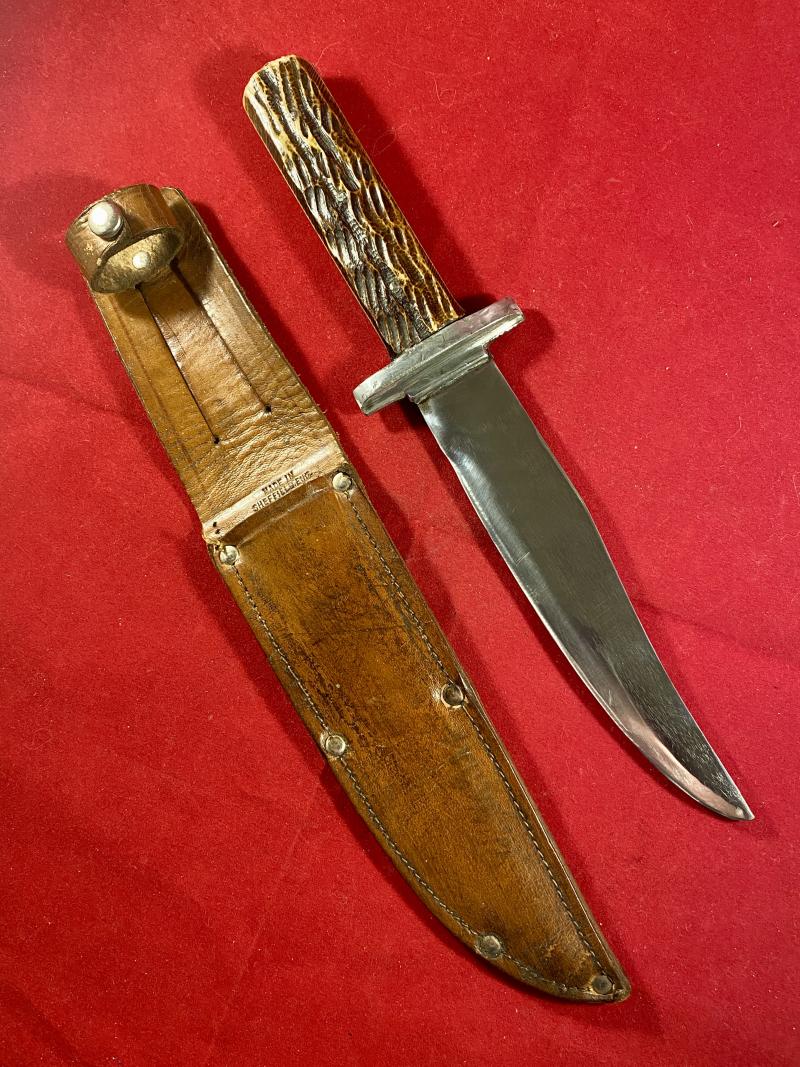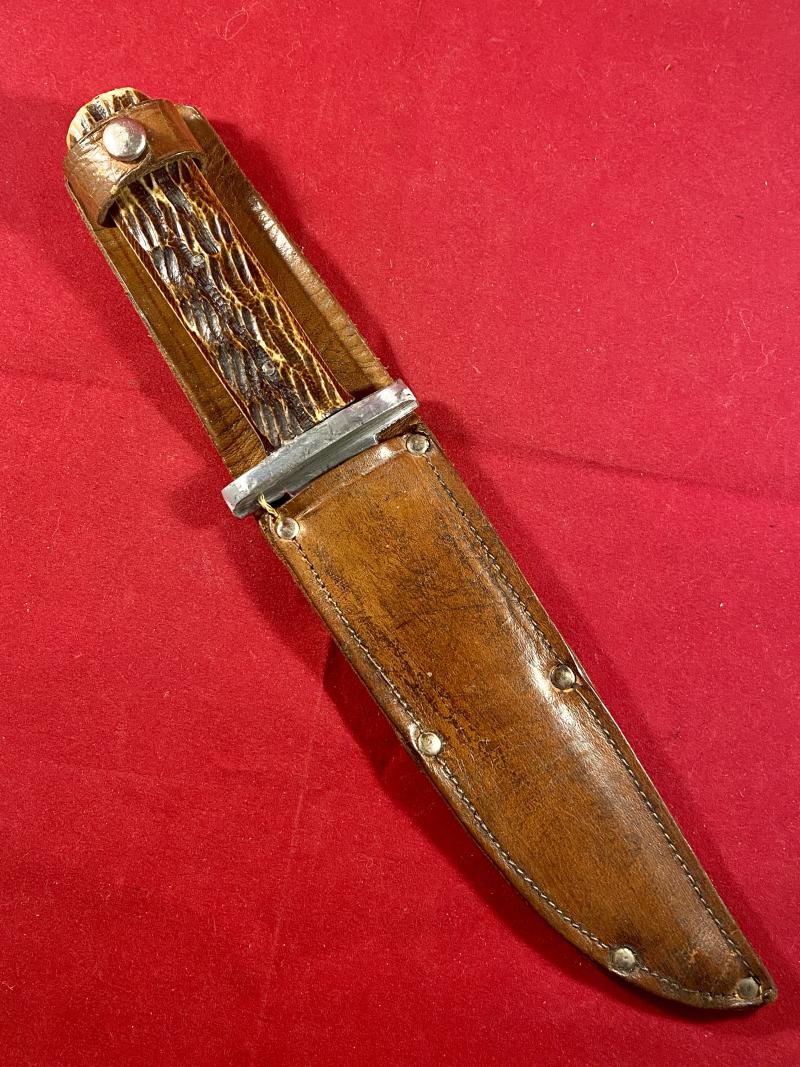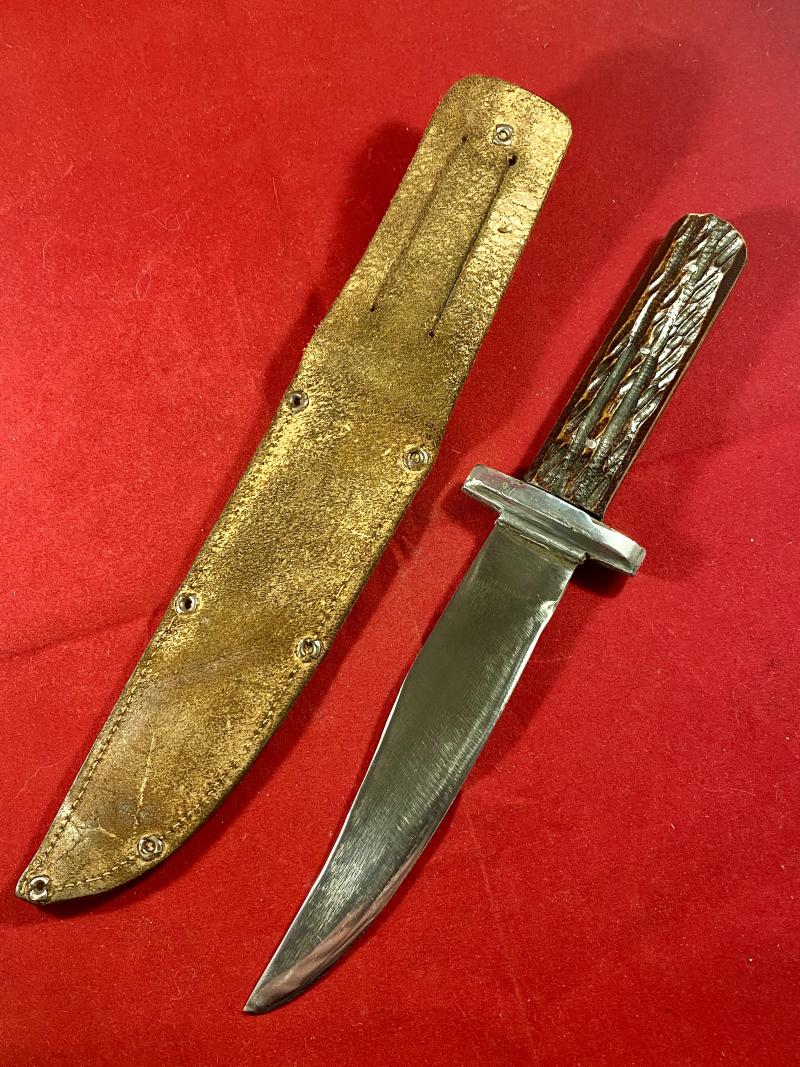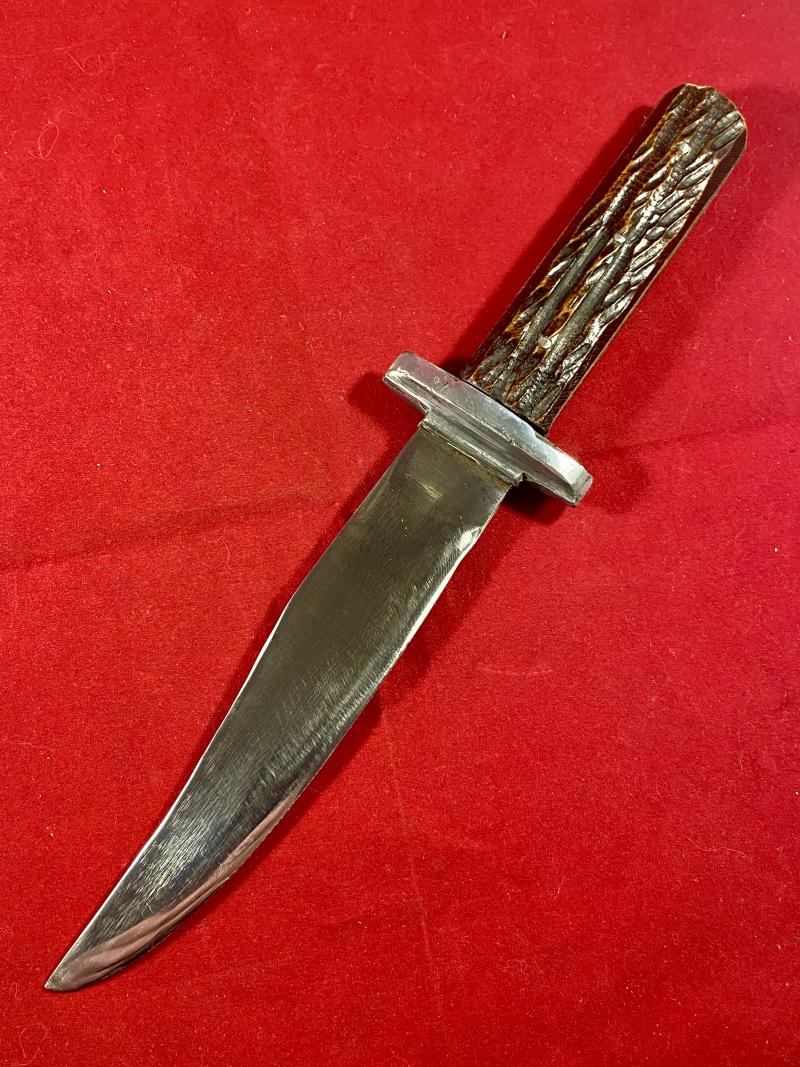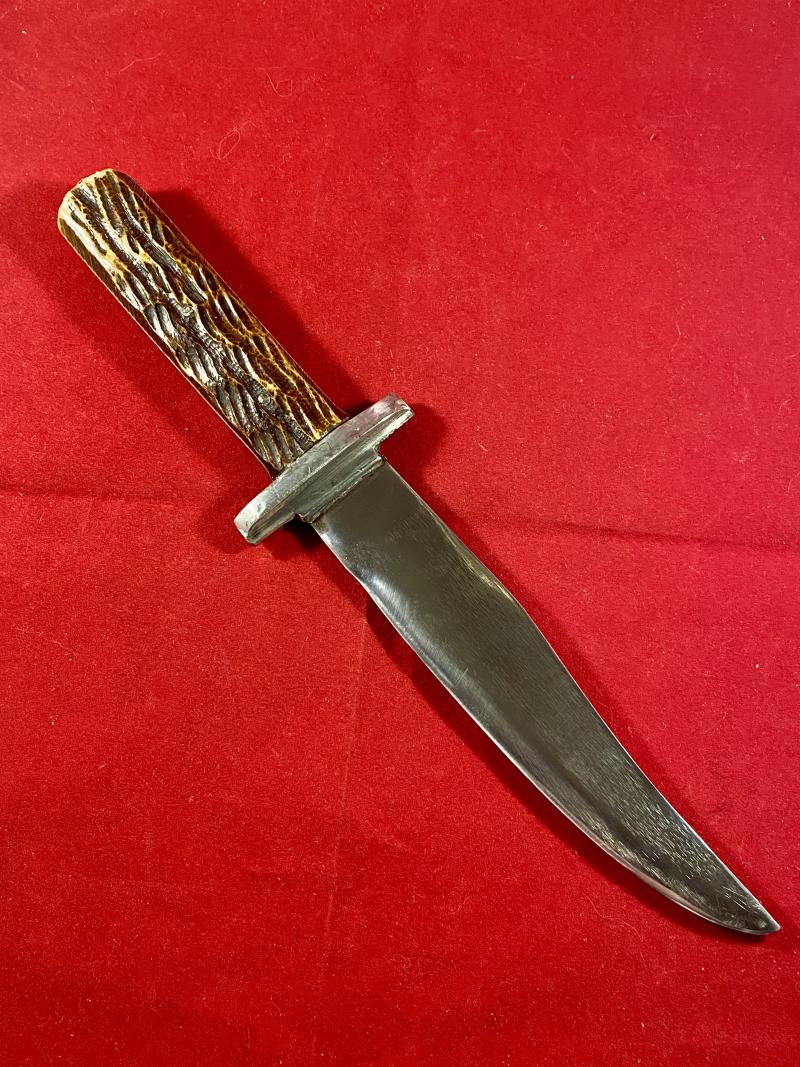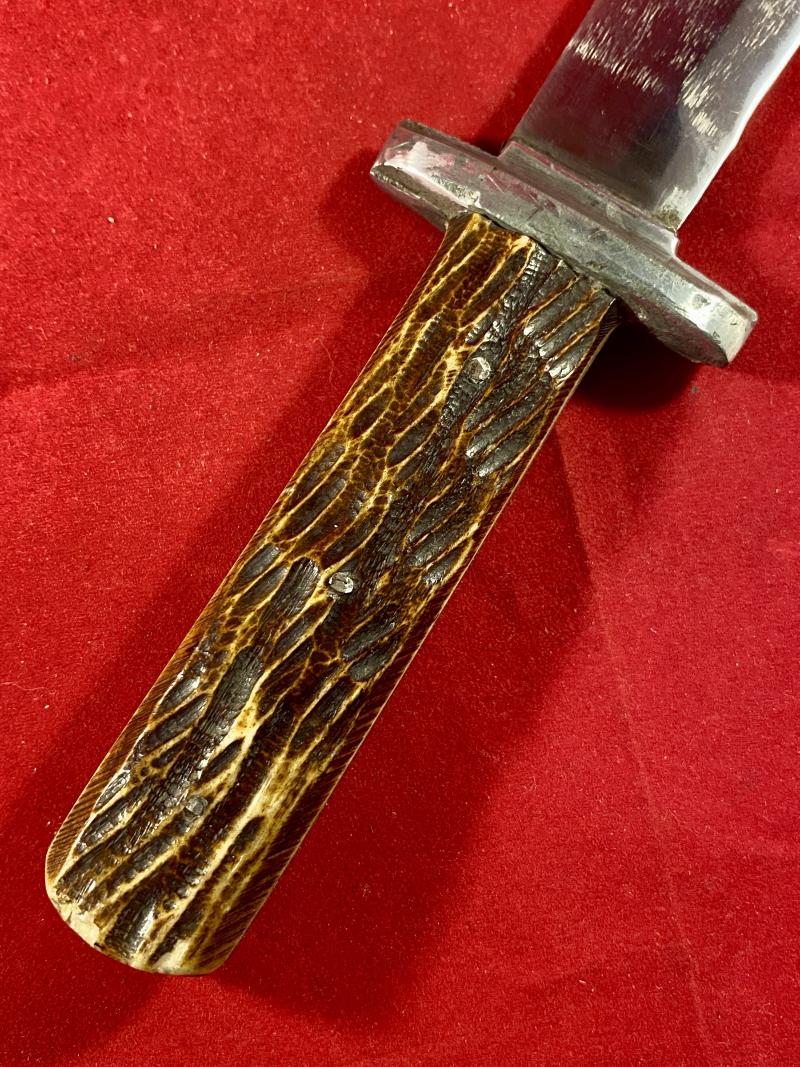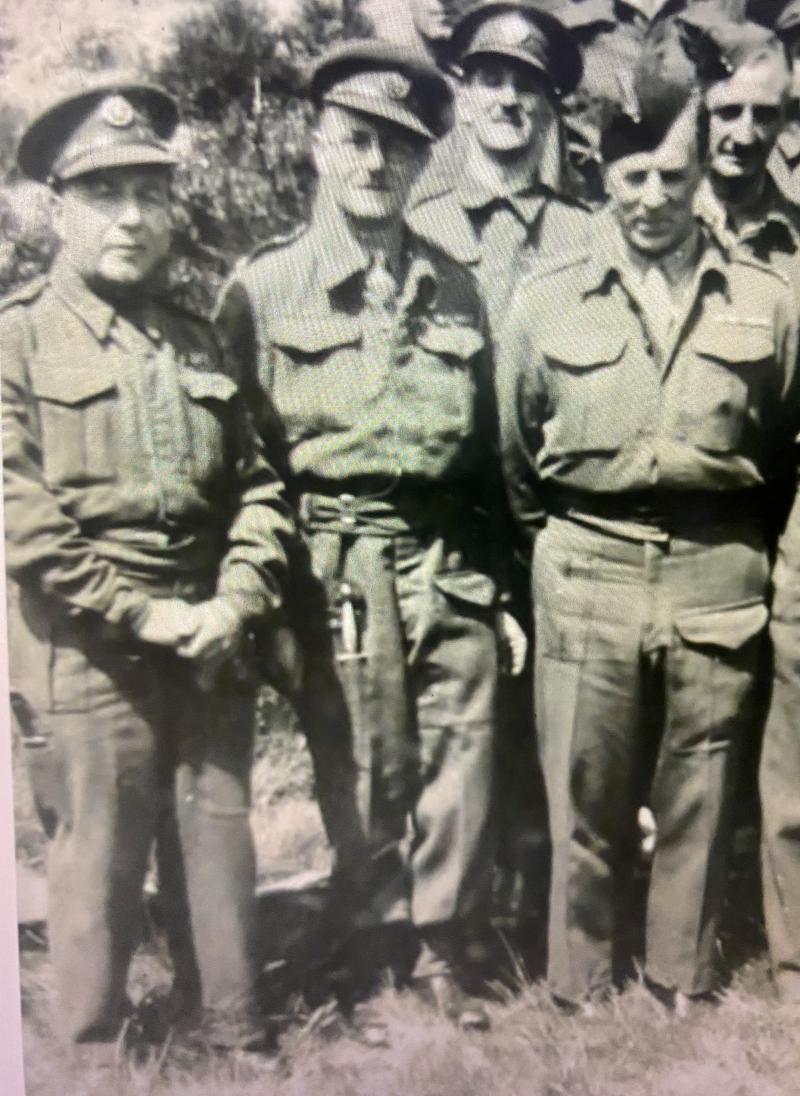Rare WW2 British Army Auxiliary Unit Knife with Leather Sheath
Here on offer is a rare example of a WW2 British Army Auxiliary Unit knife with its original leather sheath, by Joseph Rodgers and Sons.
It has only been recently that this type of knife has been authenticated as being used by the British Auxiliary Units during WW2.
Credit must go to Ron Flook, who through his outstanding research into military knives, has managed to confirm that these knives where actually used by British Auxiliary Units during WW2.
His excellent book, ‘British and Commonwealth Military Knives’ actually shows a photo (plate 549) of one of these knifes and a supporting explanation about them, on page 229.
He explains that this seemingly pure commercial sheath knife would appear to have no military origins.
However, two examples have been observed, each with connections with Britain's WW2 Resistance Army, the Auxiliary Units.
One example in the Dorset Military Museum, Dorchester is identified having been issued to a member of the Auxiliaries who had subsequently donated his knife to the museum.
Another example has been recorded as being issued to an Auxiliary Unit member based in north Cornwall. There is a photo of this officer wearing an Auxiliary Unit knife in his right trouser pocket, while standing next to another officer who is seen wearing a FS knife. (Please see the last photo in my listing).
In its scabbard it measures 10.25” (26cm) long and weighs 157g.
The knife blade measures 5.5” (14cm).
This knife has a thin and flexible, yet strong 5.5” blade with long clipped Bowie back edge and retains a sharp cutting edge.
Apparently, these knives were made by Joseph Rodgers and Sons and two types of makers marks have been noted but they were only very lightly etched on to one side of the blade. The blade on this example is has been highly polished and no maker’s marks are now visible.
The plain oval shaped crossguard is made from cast aluminium and now shows some usage dings to the finish.
The grip is made up of two beautiful jigged bone scales that are secured to the tang by three steel pins.
A variety of leather sheaths have also been noted with these knives and this one still retains what appears to be its original curve shaped stitched and riveted sheath, with its stud fastening grip strap and slotted belt loop. On the front near the belt loop, it is stamped:
MADE IN
SHEFFIELD ENG
This example is in excellent condition and come from a private collection where it is claimed it was acquired from a serving WW2 Auxiliary Unit officer.
Further supporting reference material was again written by Ron Flook in the March 2021 issue of KNIFE Magazine, under the heading of “Britain’s Resistance Army Knife”.
I have reproduced the article here for reference and all the credit for this work must go to Ron Flook.
As the Auxiliary Units were formed in early 1940, before the general issue of the F-S knife, the provision of an ordinal commercial item such as this is highly likely.
After the retreat from Dunkirk Britain lived with the threat of invasion by the Germans, but unlike the other European countries it set out to be prepared for such an event. Amongst these preparations was the setting up of a fully organized underground resistance Army, an Army that became known as the Auxiliary Units.
The idea of such units came in many respects before the actual start of WW2, when some in the Secret Intelligence Service and Military Intelligence took the threat of German territorial expansion more seriously than others. This resulted in the creation of Military Intelligence (Research) which studied the impact of irregular warfare. One of the architects of the Auxiliary Units was Major General Gubbins, who went on to lead the SOE. Gubbins had studied the impact of irregular forces in a number of theatres and was the co-author of a training manual on irregular warfare tactics for resistance movements, this was translated and dropped into occupied Europe.
The Auxiliary Units comprised of three different sections, the Scout Sections, Special Duties Branch, and the Auxiliary Unit Patrols. The Scout Sections were units of regular soldiers, each commanded by a Lieutenant, whose role was to train the patrol of the Auxilia-ty Units. It was composed of men who had experience in mountaineering, hiking and with initiative for working independently and who could pass on these skills. The Special Duties Branch consisted of observers and runners, and was responsible for the clandestine radio system.
The Auxiliary Unit Patrols were the Armed wing and formed a resistance network of highly trained volunteers prepared to be Britain's last ditch line of Defence. The men were all volunteers and they operated in a network of cells from hidden underground bases around the UK. These Operational Basos (OB's) were constructed in all manners of places such as old mine shafts, the ice house of a country house or newly built bunkers in secluded woods. All were within striking distance of important lines of communication such as railway lines and road bridges along with military targets such as airfields. Working in teams of generally six or eight man patrols, although some were larger, their role was to disrupt these lines of communication thus hindering any German advance. It was estimated that they only had a likely life expectancy of six weeks and their very existence remained a secret for many years after the end of WWII. Despite this potentially highly dangerous work and because of the secretive nature of the units, they received virtually no official recognition after WW2 and it was only due to the efforts of some veterans that they very belatedly received their WW2 medals.
The role of supplying the auxiliary Units fell to Ashton House, which in its early days formed part of MI6’s section D but in July 1940 became SOE’s Station 12. The establishment was run by Lt. Col. Cardew Wood who in conjunction with Fairbairn and Sykes was instrumental in getting the F- Fighting knife made that would in due course be issued to the Auxiliary Units.
Prior to the F-S knife becoming available, there was need to provide the Auxiliary Units with a knife. There have long been stories that a small hunting style knife had been used by the Auxiliaries with a few examples made by Joseph Rodgers having reported provenance and some images of Auxiliary members sowing such knives in wear. This style of knife was made by a number od Sheffield firms, sold as scout knives and they appear in a Rodgers catalogue from 1938 but the questions remained as to if there was any actual evidence they were the knives issued.
The answer to that was finally found in the Ministry of Supply Contract Record Books held by the UK Archives.
The earliest record for “300 Knives Hunting complete with Sheaths” is dated to the 20th August 1940 and placed with Joseph Rodgers and Sons Ltd.
On the 14th September 1940 a further order is placed with Rodgers for 1000 knives with a note for “Aux Units” It is remarkable that the name Aux Units is quoted, given the then secret nature of the organisation. The record gives a stores number of KF7954 and even though the allocation of this number predates the introduction of the F-S knife it in due course was attached to the F-S knife. Delivery stated was within 14 days.
The next record is for “1100 Knives Hunting complete with Sheaths KF7954” and was placed with Joseph Rodgers and Sons Ltd. Pond Hill, Sheffield on the 6th November 1940 at a price of 34 shillings per dozen.
Although a variety of other makers can be found for this style of knife, which all follow the same basic pattern, the evidence from the Ministry of Supply contract record books would point to only Joseph Rodgers receiving official orders for 2400 knives.
These plain knives served an urgent need during one of the darkest periods of WW2, when Britain stood alone against Nazi Germany and the threat of invasion.
The knifes blade measures 5.5” (11.5cm) long and the whole knife measures 9.6” (24.5cm) long.
It weighs 177g.
Please see my pictures for the details of the condition, which complement this description.
Please see my TERMS OF BUSINESS regarding Deliver Charges and Insurance regarding additional insurance cover, should you require it, BEFORE the item is dispatched.
The responsibility lies with the customer to check with your Customs restrictions that this item can be imported into your country.
Thank you for taking the time to look.
Code: 51736
275.00 GBP

